
Getu Valley is a very recent addition to climber's destination list, but after the Petzl Roctrip showcased the amazing rock architecture and variety of styles, it is sure to become a classic destination, especially when a trip links both Getu and Yangshuo. In addition to this, Getu is even more of a blank canvas, further appealing to more adventurous climbers wishing to open new routes.
Today, the Getu topo is available for free download on the Petzl Website, and as it's fame is slowly spreading the effects of the steady stream of climbers are noticeable, as more and more of the locals open their houses to guests, buy fridges for beer and even sell cartons of milk. There are menus in English and even chalk bags available in traditional miao cloth. The first coffee machine is yet to arrive, but I've seen some of the more curious and enterprising village dwellers taking note when we brew up, we won't be waiting long, I expect.
Getu has over 200 routes ranging from 5+ to 9a, with everything from long slabs to short powerful overhangs as well as multipitches on a similar range, from the CMDI Wall where 180 metres of climbing is available to anyone with a harness and an ATC, to the daunting Corazon de Ensueno, put up by Dani Andrada, and in his own words "maybe the most overhanging route in the world". This is a climbing destination for anyone who finds themselves in this part of the world with a few quickdraws and a harness. Be warned however that at the top of the climbs you won't find much more than two bolts tied together by a piece of two year old rope, and a single maillon to lower off from, which may be stuck shut and need threading. (There is no local climbing scene here, only passers by).
Our goal this time was Pussa Yan, one of the more beautiful pieces of rock in the area, a free standing triangle 180 metres tall, and with one route straight up the middle, La Casse Tete Chinois, six pitches of beautiful climbing on a fantastically picturesque piece of rock. We set off at 5am in the dark, hoping to be finished by the time the sun cam round on to the face after lunch. By the time we picked up our gear from where we had stashed it the night before it was raining, and we walked to the base of the cliff as dawn broke and the rain stopped in time for us to put on the harnesses and step off the ground. The first pitch we set off up turned out to be one of those bolted since the original Roctrip, and probably closer to 6b than 6c. Two pitches a notch harder – steady slabs apart from a few rude moves shortly after leaving each belay and by 10am we were on the ledge half way up the cliff. A perfect chance to spend five minutes eating and watching the locals make their way through the rice harvest in the fields, spread out below us in shades of yellow and green, the crop falling in silence to the arcing blades, and giving up their grain with a dull thud as the stalks are beaten against the wooden tubs dotted around. Some aspects of life have hardly changed in the last few thousand years here.

The next pitch is the first 7a, and with some more sustained climbing than the lower section, it feels it. One more easier pitch, and then finally a technical slabby traverse up to the top - spectacular climbing in a truly spectacular location. After a pleasant lunch of whisky and flapjack on top of the crag, we set off on the walk down, and managed to get a few snaps of some friends climbing the equally impressive CMDI Wall immediately behind.
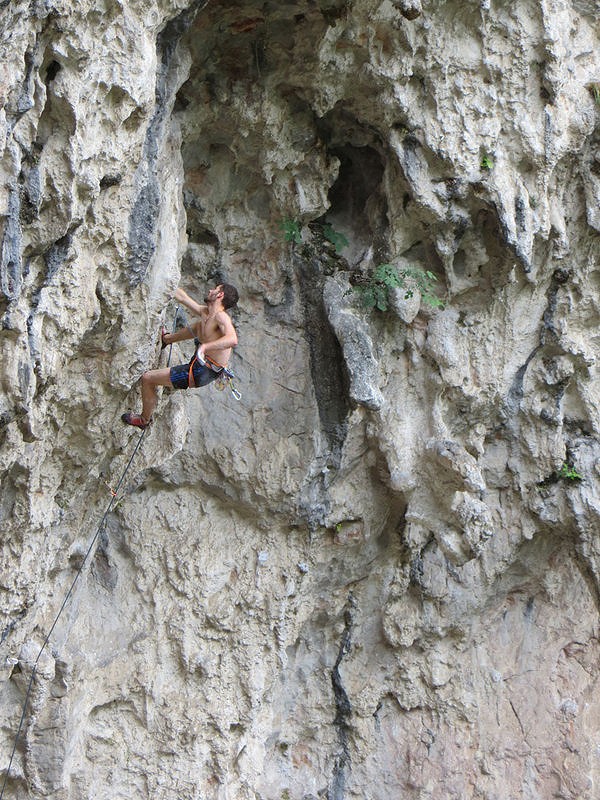
Logistics
When to Go
Guizhou is famous for having "No three acres of flat land, no three days without rain, and no three coins in anyone's pocket" it is still possible to climb here all year round. Sectors such as Banyang's cave, Oliver's crag and the Great Arch are all well protected from the rain, which generally comes in short periods and ranges in intensity from what might be known as 'damp air' in the UK to a more persistent drizzle and even occasional proper rain. The spring is humid and hot and the summer more so, with temperatures reaching 30° and the rock feeling at times rather unpleasant. At this time of year you will be glad of the frequent cloudy spells and the relative cool that they bring. From October to March the weather is cooler and you will need a decent belay jacket as the temperature can drop to just a few degrees above freezing. The humidity is much less at this time of year and the rock is much less likely to send you spinning off into space without warning. Don't be discouraged by rain when you are there, as many days start with mist and drizzle before clearing up into great climbing days.
How to Get There
China can be a difficult place to navigate at the best of times, and in this area it is even less likely that you will come across anyone whose Chinese extends beyond the token 'HELLO' screamed out of car windows and shops alike. A piece of paper with place names written down is an indispensible aid to travelling. From Kunming 昆明 to the west you can take an overnight train to Anshun 安顺 and then take a bus to Ziyun 紫云 which can be found on the first road on the left after walking a few hundred metres down the road immediately in front of the train station (28RMB) which takes about 2 hours and from Ziyun 紫云 you can take another bus (an hour or so) to the Getu river格凸河 park entrance. You can also hire a van and driver to take you there for about 300RMB which is easier and faster, but requires more advanced Chinese and bargaining skills.
This being China, and Getu being a national park, access to the great arch and beyond requires the purchase of a ticket at 60RMB which (at time of writing) will work all week. If you are particularly strapped for cash you might be able to beg steal or borrow a ticket from another climber, or if you can get your hands on a basket and a buffalo you could try your hand at impersonating a local (they get in free).
Accommodation Advertise here
No Premier Listings found in this area
The Getu hotel is the most expensive and has air conditioning 140 RMB a night per room. The petzl house is cheaper at about 60RMB for a room with three beds in, and hot water, and there is another similar option, the hotel down the road, who have recently invested in a flash looking porch complete with coloured lights. There is one further option right next to the entrance, and prices are negotiable, although it is worth considering that they only have an outside toilet and no running water, cold or hot.
Instructor/Guides Advertise here
No Premier Listings found in this area
Food
You can eat at a number of places and get packed lunches for less than 10RMB. Some are pretty good, and others less so, and most will let you into the kitchen to point at what you want if you are persistent. It's usually either noodles or noodles for breakfast, so if you like a bit of roughage then it's advisable to bring your own supply of oats. Likewise for anything else you might want to eat or drink other than sunflower seeds, beer, or rice and noodles.
Other Activities
Around the Getu valley there are endless places which anyone who has a mind to can explore. The caves are accessible to those who dare swim inside, and the paths that wind into the hills could lead you to discover your very own limestone paradise just around the corner. 中洞 (Middle cave) is a popular day trip and has a real National Geographic feel to it. A two hour walk into the hills will take you through another arch and back centuries to a bamboo village tucked away in an enormous cave. The higher and lower caves deserve a second roctrip, and the walk into this area really gives you an idea of the sheer quantity of untouched rock in this corner of southern China.
Travelling On
South China is a sea of unexplored, pristine karst. Not too far from Getu there are other established climbing areas in Yangshuo, Kunming and Dali where new routes are going up all the time. More recently opened areas include Baise Leye, bolted by the Kailas team, and the sandstone towers in Liming developed by Black Diamond and North Face for their annual trad climbing festival. Further information is available on ClimbDali.com, JunshanClimber.com and our own project KunmingRock.com

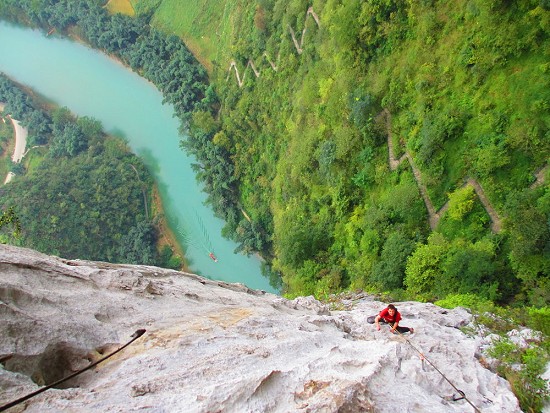

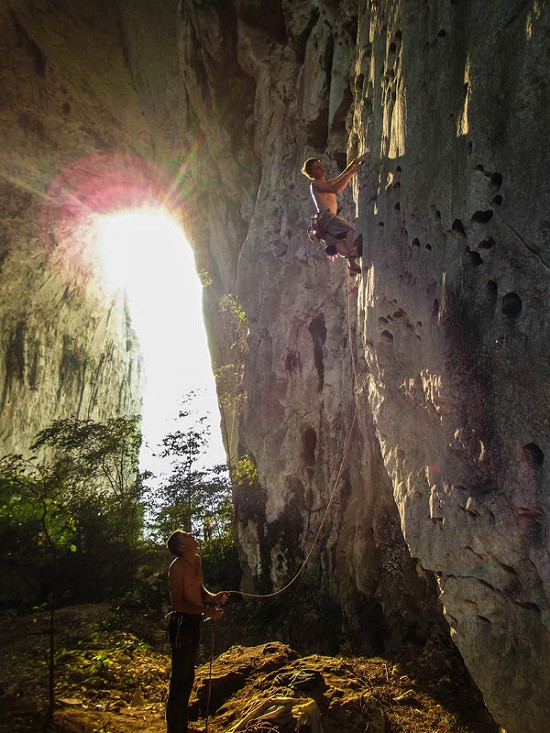

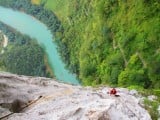

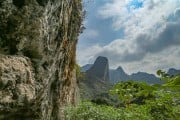

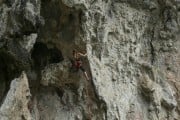

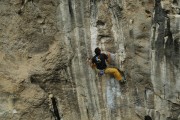
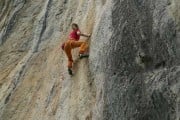








Comments